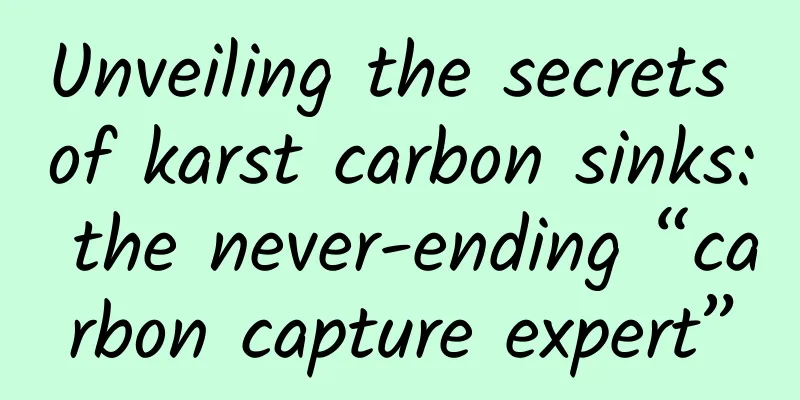Unveiling the secrets of karst carbon sinks: the never-ending “carbon capture expert”

|
The global karst distribution area is 22 million square kilometers, accounting for 15% of the land area. The global carbon sink flux generated by the weathering and dissolution of carbonate rocks is 550 million tons/year, equivalent to 33% of the global forest carbon sink flux and 70% of the soil carbon sink flux. In November 2019, the Ministry of Ecology and Environment released the "China's Policies and Actions for Addressing Climate Change in 2019 Report". In the "Increasing Carbon Sink" section, it included "The Ministry of Natural Resources actively explored four methods to increase karst carbon sinks, including artificial afforestation and grass planting, soil improvement, exogenous water irrigation and aquatic plant cultivation." This means that karst carbon sinks will play an important role in achieving the goals of addressing climate change and striving to increase carbon sinks. To understand karst carbon sink, we should first understand two concepts: carbon sink and karst. The so-called carbon sink refers to the process, activity or mechanism of reducing the concentration of greenhouse gases in the atmosphere by absorbing carbon dioxide in the atmosphere through measures such as afforestation and vegetation restoration. It includes terrestrial ecosystem carbon sink, marine carbon sink and geological carbon sink. Karst, also known as karst, is a general term for landscapes, phenomena and their processes formed by the chemical dissolution of soluble rocks (mainly carbonate rocks) by water, accompanied by water erosion, sedimentation, and gravitational collapse of rock bodies. Among them, the weathering of carbonate rocks that consumes carbon dioxide in the atmosphere is called karst carbon sink. Karst carbon sink belongs to geological carbon sink. In this process, carbon dioxide in the atmosphere is continuously removed and enters the hydrosphere in the form of HCO3-, thus playing the role of carbon sink. Karst landform The karst carbon cycle has great potential, but the cycle process is silent. Carbonate rocks are soluble rocks, and their weathering and dissolution rates are dozens to hundreds of times that of silicate rocks. Normally, rainwater dissolves carbon dioxide in the atmosphere and soil to form carbonic acid, which then dissolves carbonate rocks to form karst water bodies containing HCO3- and Ca2+. In this process, carbon dioxide in the atmosphere is continuously removed and enters the hydrosphere in the form of HCO3-, which plays a corresponding carbon sink effect. The carbon sink produced by the inorganic carbon cycle driven by carbonate rock weathering is very hidden. The fundamental reason is that carbonate rocks were formed in a warm, sunny, and clean shallow sea environment during the geological history period, and their dissolution process is also displayed through clear and transparent karst water. Therefore, the karst carbon cycle process is silent. Karst Forms--Stalactites The karst carbon cycle at the basin scale usually includes three parts: occurrence, migration and transformation. 70% to 80% of the karst carbon cycle occurs in the shallow karst surface zone, and only a small part occurs in underground rivers and underground caves. During the migration process of HCO3-rich karst water, chemical deposition (stalactite formation) occurs in the cave due to oversaturation. A small part of HCO3- is converted into carbon dioxide and escapes into the cave air. More HCO3- flows with the flow of groundwater, flows out of the surface in the form of springs and underground rivers, and is carried to rivers, lakes and oceans. Part of the carbon will sink to the bottom of the water with sedimentation. These karst waters with high concentrations of inorganic carbon stimulate aquatic plants to photosynthesize, converting part of the inorganic carbon into organic carbon. Karst Forms--Stalactites It should be pointed out that the driving forces of the karst carbon cycle are water and carbon dioxide. Under different climate types, the intensity of carbon sinks varies due to different conditions such as temperature, rainfall conditions, CO2 concentration, vegetation coverage, soil composition, underground space, etc. Karst carbon sinks can also increase if human intervention changes the driving force. We can increase karst carbon sinks through vegetation restoration, soil improvement, exogenous water action and enhanced photosynthesis of aquatic plants. First, vegetation restoration. Vegetation restoration can enhance soil respiration, increase soil carbon dioxide concentration, significantly increase underground karst carbon sinks, and also increase surface biological carbon sink flux. Second, improve soil. The carbon in karst carbon sinks mainly comes from soil carbon dioxide. Artificial soil improvement can increase the activity of soil organisms and soil porosity, and increase soil carbon dioxide circulation to enhance the karst carbon sink effect. Third, pay attention to the role of exogenous water. Exogenous water from silicate rock areas has strong erosion power. Typical basin monitoring results show that in the Maocun underground river basin in Guilin, the carbon flux of karst water increases nearly 10 times after the water in the upstream non-karst area flows through the karst area; the monitoring results of the Lijiang River basin show that when the distribution area of carbonate rocks in a small basin is about 50%, the exogenous water has the greatest impact on the karst carbon sink. Fourth, enhance the photosynthesis of aquatic plants. The bicarbonate ions in karst water can provide the necessary carbon for underwater plant photosynthesis. Calcium ions are not only the necessary mineral elements for the growth of aquatic plants, but also can promote the utilization of inorganic carbon by aquatic plants. Karst water has a "fertilization effect" on aquatic plants. Underwater plant photosynthesis consumes bicarbonate ions in the water, converting the carbon in it into stable organic carbon, while reducing the concentration of bicarbonate ions in the water, maintaining the stability of the carbon migration process in the karst water. Karst landforms are widely distributed in my country, and karst carbon sinks are of great significance to my country's realization of the "dual carbon" goals. In October 2021, the "Opinions of the CPC Central Committee and the State Council on the Complete, Accurate and Comprehensive Implementation of the New Development Concept and the Work of Carbon Peaking and Carbon Neutrality" and the State Council's "Carbon Peaking Action Plan before 2030" proposed the carbon sink capacity consolidation and improvement actions of "actively promoting the development and utilization of karst carbon sinks" and "conducting a basic survey of karst carbon sinks". Karst carbon sinks are included in the top-level design of the national "dual carbon action" as an important technical means to achieve "carbon neutrality". This will help give full play to the potential role of karst carbon sinks in responding to global climate change and make important contributions to the construction of ecological civilization and sustainable development. (Text by Wei Yanlan, Assistant Researcher, Institute of Karst Geology, Chinese Academy of Geological Sciences; Wang Li, Associate Researcher, China Geological Library; Li Wenli, Associate Researcher, Institute of Karst Geology, Chinese Academy of Geological Sciences) |
>>: Across a century, we meet the "Chinese Marie Curie"
Recommend
How to add official Android app to the market? How to add official labels to major Android markets!
Many people are asking how to add an “official” l...
The most marketing-savvy post-90s generation tells how I launched two new brands with a valuation of over 100 million yuan
Insight, circle of friends marketing , topic igni...
A new strain of the virus has arrived? It has been found in more than 60 countries around the world! Will it come to our home?
If you ask what everyone is most worried about re...
The Ministry of Industry and Information Technology has stopped Apple's Callkit, and WeChat can no longer answer video calls directly
Apple has development tools such as ARkit, Classk...
Introduction to the basics of category operations
Category operation is also called product operati...
This is the best of times, and the worst of times
This is the worst of times, the worst of times—so...
The development trend of tools such as Alipay and Meitu
The following is an outline of this article: 1. W...
Shanghai Synchrotron Radiation Light Source takes pictures of molecules
Produced by: Science Popularization China Author:...
No longer putting new wine in old bottles, Xunlei Transformation Concept submits IPO application again
On May 24, it was reported that Xunlei had resubm...
How did the tropical rainforest become the "kingdom of species"?
Produced by: Science Popularization China Author:...
There is a "shadow killer" in the newly renovated house. Who has found the "nemesis" to subdue it?
Colorful wallpaper, brand new furniture, clean fl...
Electric fan + mineral water bottle instantly turns into a "cooling artifact", is there any scientific basis for this?
Recently, a short video of "loading mineral ...
Which Zhejiang Mobile high bandwidth server rental company is the best?
Which Zhejiang Mobile high-bandwidth server renta...
Why does MCN do live broadcasts without selling products?
In the recent live broadcast, there is a breath o...
This is the most common model of user operation. Come and take a look. It is written in great detail!
As an operator , you must have done this: invite ...









